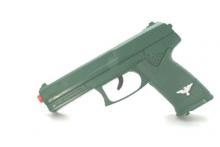
Children have fantasized about triumphing over evil for years. Fighting the “bad guys” seems to be an inherent desire, especially for boys, who use gun play as a means to feel empowered. Whether children are playing cowboys and Indians, cops and robbers, pirates, soldiers, or spies, play guns are usually involved as they engage in pretend play.1
The wide open spaces that allow outdoor play are ideal for all kinds of gun play. Whether children are playing with realistic-looking toy guns, Nerf blasters, squirt guns, or sticks, they are usually running and chasing each other while enjoying the opportunity to be boisterous and noisy outdoors.2
Imaginative play that involves playful aggression is often seen in rough and tumble play as well as in play involving fantasy weaponry. Make-believe fighting helps children make sense of their world and plays a part in helping them work through their impulses and inner struggles. They tend to learn their limits and hold back from being too rough when they regularly wrestle and play fight.3
It is believed that aggression is part of human nature, and a child’s interest in playing with toy guns, swords, or other make-believe weapons is often generated by what he sees other children playing. Television programs, including the news, can also trigger interest in playing make-believe with guns.4
While some parents and educators would like to discourage aggressive behavior and would prefer a zero-tolerance policy for allowing children to play with toy guns, children demonstrate their strong fascination with guns by using sticks, Legos, or anything they imagine to be a pretend gun when they don’t have a more realistic toy gun. Despite fears of school violence and aggression, researchers have not found any correlation between actual gun use in later years and early-childhood fondness for toy guns. It has been shown that those who become violent were usually bullied, grew up in households where guns were used, lived in areas where guns were part of the youth culture, or felt lonely and estranged from others.5
- 1. Huffman, Todd. “Toy Guns and Gunplay: Should Parents Be Worried?” McKenzie Pediatrics. < http://www.mckenzie-pediatrics.com/shop/images/ToyGuns.pdf > 15 June 2011.
- 2. Rich, Diane. “Bang, Bang! Gun play, and why children need it.” Early Education. Summer 2003. < http://www.richlearningopportunities.co.uk/pdf/bang%20bang%20gun%20play%20and%20why%20children%20need%20it.pdf > 14 Sep. 2011.
- 3. Knuth, Jenny. “Bang! Bang! You’re Dead!” Mothering Magazine. Issue 139, November/December 2006. < http://local.mothering.com/Bang_Bang_Youre_Dead_Detroit_MI-r1209769-Detroit_MI.html > 7 March 2011.
- 4. “Your Child and Gun Play.” Fisher-Price. < http://www.fisher-price.com/fp.aspx?st=10&e=parentresourceexpertadvice&content=36478 > 14 Sep. 2011.
- 5. Op. cit., Knuth.

